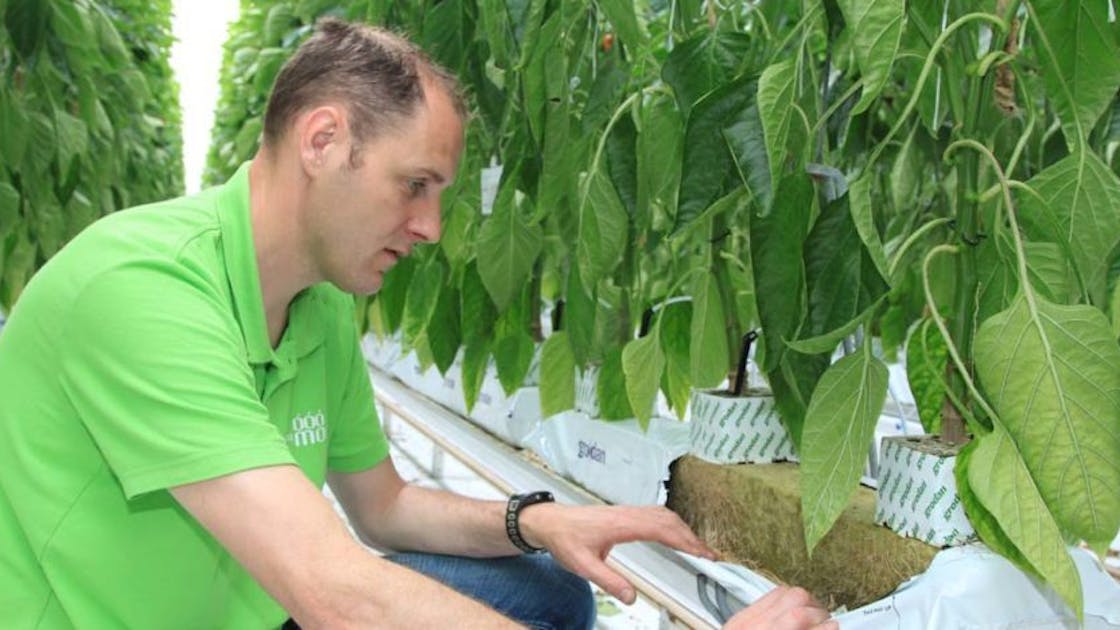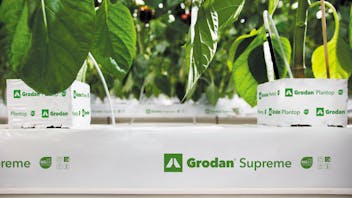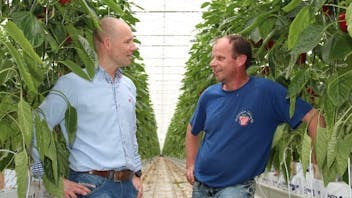Growers are enthusiastic about a new stone wool slab specially developed for the cultivation of sweet peppers (using the V system). Grower Rob Moors, based in Asten-Heusden (the Netherlands) was delighted with his plants’ excellent root system that was more effectively distributed throughout the entire slab than in the case of the slab he had used until then. “The greatest advantage is the broader control range, enabling you to grow a better balanced crop,” he says. “That should result in greater vigour and production.”
The new sweet pepper slab is Grodan’s Supreme, which was tested for the first time in trials by the end of 2014. Since then, several growers have gained experience with it, and they are without exception enthusiastic about their results. Because of its dimensions (1.0 m long, 12 cm wide and 10 cm high) the slab is only suitable for the V cultivation system, which is the system used by Rob Moors from Heusden. He is now using this slab for the third season in a row at his nursery’s primary production site in Asten-Heusden, where he grows the red pepper variety Red Line on an area of 8 hectares. Moors plants three plants in each slab and grows plants with four stems.
“In 2015 we did a trial using the new slab in an area of two hectares,” says the sweet pepper grower. “In the other six hectares we were then still using Grodan Vital, with which we were also very satisfied. Last year we expanded to fifty-fifty and we now use the Supreme slabs for all our crops. At our other production site in Someren we grow green and yellow sweet peppers outdoors, in an area of six hectares. As the surface of the land isn’t as smooth as when you grow crops in gutters I don’t like to use high slabs there.”
Different fibre structure
At 12.0 litres, the volume of the Supreme slabs is a little larger than that of the Vital slabs (15 cm wide, 7.5 cm high), which is 11.25 litres. That little extra volume is advantageous, but it doesn’t explain why the new slab performs so much better.
“The difference lies mostly in the stone wool itself, which is based on our Next Generation 2.0 technology and has a slightly different structure and physical properties than the stone wool of the first generation,” explains Frank Janssen, account manager for vegetable crops. “The horizontal and vertical distribution of water have both been improved to enable the plants to benefit more from the total slab volume. The bottom part of the slab is on average a little drier, while the top part remains moist enough to ensure an adequate supply of water and nutrients to the roots for a fairly long time. This results in more uniform root development throughout the entire slab, and roots with more fine, active growing points.”
Roots penetrate the entire slab
“I’m really thrilled about the way the roots penetrate the entire slab,” says Rob Moors. “That really is a major improvement in comparison with the other slab, in which the roots grew mainly in the bottom part. They also seemed to be a bit thicker and less finely branched. In my experience the roots in the new slab are healthier, ensuring stronger, more vigorous plants.”
At the beginning of the season the grower observed no major differences, but he began to note distinct improvements after the longest day. “In 2015, when I was able to compare the two slabs closely throughout the season, I found that the crops were looking a bit fuller and more uniform and vital. They benefitted from that better condition at the end of the season. Last year the damage caused by the severe hailstorm we had in June unfortunately forced me to end the season early. But by then I had already gained enough confidence in the new slab to know that I wanted to use it for all my crops this season.”
Broader control range
The greatest advantage of the new sweet pepper slab according to Moors is its broader control range. “That enables you to more actively explore the limits of what’s possible and keep your crop better balanced. You can safely allow your slabs to dry out more, in the knowledge that they will quickly become resaturated,” he explains. “On days of high insolation I can continue to irrigate my crops longer in the late afternoon and early evening to keep them active without any risk of that adversely affecting the drying process during the night. With the old slabs I really had to switch off my irrigation earlier.”
“Another advantage of the Supreme slabs is the way all the water in the slab is quickly replaced by fresh water during irrigation,” adds Frank Janssen. “This prevents the risk of the EC in the slab increasing too quickly and enables you to either safely give your crop water with a higher EC to prompt a generative impulse, or lower the EC with relatively small doses of water to achieve the opposite effect. And you can work with a lower drainage percentage.”
Slab sensors
For a few years the grower has been using Grodan’s wireless GroSens MultiSensor system so as to be able to get the most out of his slabs and crops. At different points throughout his nursery he has installed six sensors to measure water contents and EC values 24/7. The measurements are sent in real time to the computer system, and Moors regularly logs in to the system to check whether everything is going according to plan.
“This system works really well for me,” he says. “It’s reliable and provides a representative impression of the root environment. You can really get more out of your crop by closely monitoring it and taking action to adjust conditions whenever necessary.”
Moors started to pay closer attention to his irrigation strategy around four years ago. That led to several advantages, the most important being a stronger root system, a more vital crop and fewer problems caused by diseases, plant losses and fruit quality. And all that – quite understandably – also led to greater production and a better fruit quality.
“An added advantage was that I was using less water and fertilisers and could work with less drainage,” says the sweet pepper grower. “I’ve found that I can refine conditions even further with the new slab. I haven’t really tried pushing things to the limit, but the way my crops are looking now makes me expect that they will produce more kilos in the second half of the season than I would have harvested with my previous slab.”
Trials revealed higher early and late production
The sweet pepper slab was specially developed for the V planting system. The traditional 4-row system calls for other dimensions. Grodan is currently developing a sweet pepper slab specifically for that system too.
The past two seasons Moors and four other growers performed trials with the Supreme slab. Their results enabled comparison with the stone wool slabs Vital and Grotop Expert, which are more or less the standard slabs used in the cultivation of sweet peppers.
Frank Janssen: “The qualitative and quantitative comparisons showed that plants do better in our new slab in terms of vigour, uniformity and root development throughout the entire slab volume. We observed fewer stems lagging behind in growth. At some of the nurseries the plants started producing fruit a little earlier, in spite of the fact that their irrigation strategy was not specifically based on the slab. If you do base your irrigation strategy on conditions in your slab you can more effectively promote generative growth and you’ll benefit more from the effect. Something else we noted is that the crop was more vital at the end of summer, resulting in significantly higher production in autumn. So the advantage that started with earlier production in spring continued right into autumn.”







